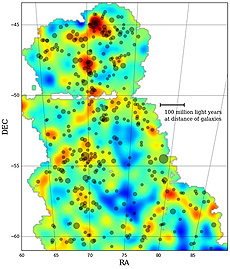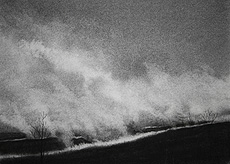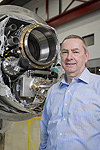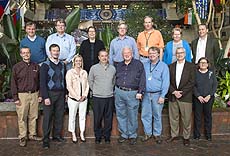|
|
Mapping the cosmos: Dark Energy Survey creates detailed guide to spotting dark matter
 |
| A new Dark Energy Survey analysis will help scientists understand the role that dark matter plays in galaxy formation. Image: Dark Energy Survey |
Scientists on the Dark Energy Survey have released the first in a series of dark matter maps of the cosmos. These maps, created with one of the world's most powerful digital cameras, are the largest contiguous maps created at this level of detail and will improve our understanding of dark matter's role in the formation of galaxies. Analysis of the clumpiness of the dark matter in the maps will also allow scientists to probe the nature of the mysterious dark energy, believed to be causing the expansion of the universe to speed up.
The new maps were released today at the April meeting of the American Physical Society in Baltimore, Maryland. They were created using data captured by the Dark Energy Camera, a 570-megapixel imaging device that is the primary instrument for the Dark Energy Survey (DES).
Dark matter, the mysterious substance that makes up roughly a quarter of the universe, is invisible to even the most sensitive astronomical instruments because it does not emit or block light. But its effects can be seen by studying a phenomenon called gravitational lensing — the distortion that occurs when the gravitational pull of dark matter bends light around distant galaxies. Understanding the role of dark matter is part of the research program to quantify the role of dark energy, which is the ultimate goal of the survey.
Read more
|
Drawing fire
 |
| Local artist Todd Serrano captured in charcoal this image of a controlled prairie burn at Fermilab. Image: Todd Serrano |
|
On-site volunteer cleanup - Thursday at lunchtime
Help keep Fermilab's site clean. Join the Third Thursday Lunchtime Cleanup crew to clean areas of the site on Thursday, April 16, beginning at 11:45 a.m. Lunch and refreshments will be served at about 12:45 p.m. Cleanup gear will be provided.
If you plan to volunteer, please RSVP to Jeannette Olah via email or at x3303 by Wednesday at 10 a.m. You may also contact her with questions.
Volunteers should plan to meet at the east ground-floor entrance of Wilson Hall at 11:45 a.m. sharp for transportation to the cleanup site.
|
Dark matter illuminated in new high-resolution maps
From Space.com, April 14, 2015
BALTIMORE — In the universe, dark and light tend to cluster together, according to new maps that chart the location of dark matter over a large portion of the sky.
The new maps show that in some places there are large amounts of dark matter, while in others it is almost entirely absent. The researchers who made the maps also looked at the location of regular matter — huge clusters of galaxies — and show that the two appear to be linked: the galaxy clusters tend to lie close to where the dark matter lies.
The map, produced from data taken by the Dark Energy Survey, was released yesterday (April 13) here at the April 2015 meeting of the American Physical Society. The new map is in agreement with current theories, which suggest that the enormous gravitational pull of dark matter would pull regular matter toward it — bringing the dark universe and light universe together.
Read more
|
|
NOvA, Pepin Carolan earn Department of Energy recognition
 |
|
Nigel Lockyer
|
The NOvA project and its leadership have been recognized by the Department of Energy with two prestigious awards: The NOvA project received the Secretary of Energy's Award of Excellence, and Pepin Carolan of the Fermilab Site Office earned the Federal Project Director of the Year award. Both awards were presented by DOE Director of Management and Administration Ingrid Kolb, on behalf of DOE Secretary Moniz, at the annual DOE Project and Acquisition Management Workshop in Washington, D.C., in March.
As you know, the NOvA project was particularly complex and challenging. It included the construction of a massive 14-kiloton detector in Ash River, Minnesota, and a 300-ton neutrino detector here at Fermilab, as well as upgrading the neutrino beam at Fermilab. NOvA will provide deep insight into the fundamental processes involved in the formation of the universe and understanding the differences between matter and antimatter.
The NOvA project team effectively led a large number of partner institutions — including laboratories, universities and vendors — to fabricate and assemble an immense number of state-of-the-art technical components. They produced a world-leading facility that will keep the United States at the forefront of this important physics frontier.
For these reasons, the NOvA project team earned the DOE Secretary's Award of Excellence, which recognizes an individual or team that has demonstrated exceptional results in completing a project within budget and on schedule.
Pepin Carolan has served as NOvA's federal project director since 2006. A DOE project director is a critical component for all projects, as they are responsible for ensuring the project stays on schedule and within budget and maintains compliance with quality, environmental, safety and health standards. His leadership, attention to detail, keen technical understanding and commitment to communicate were all key factors in making the NOvA project happen. Congratulations to Pepin on this well-deserved recognition.
Pepin worked closely with NOvA Project Manager John Cooper, who managed day-to-day project execution and coordinated with key partners, including the University of Minnesota.
Congratulations to everyone who was part of the NOvA team — you all played an important role in the project's success.
 |
| NOvA Project Director Pepin Carolan, left, received this year's Federal Project Director of the Year award from the Department of Energy. Fermilab Director Nigel Lockyer congratulates Carolan on the recognition. Photo: Reidar Hahn |
 |
| Many people have contributed to the success of the NOvA project. Front row, from left: Greg Bock, Tim Meyer, Whitney Begner, Nigel Lockyer, John Cooper, Rick Tesarek, Pepin Carolan, Gina Rameika. Back row, from left: Jim Strait, Mike Lindgren, Patricia McBride, Steve Dixon, Paul Derwent, Elaine McCluskey, Peter Shanahan. Not pictured: Carl Bromberg, Halley Brown, Harry Ferguson, Bill Freeman, Ken Heller, Etta Johnson, Pat Lukens, Ting Mao, Marvin Marshak, Leon Mualem, Stuart Mufson,TJ Sarlina, Susan Saxer, Rich Talaga. Photo: Reidar Hahn |
|
Universe's expansion may not be accelerating as much as thought, say scientists
From The Christian Science Monitor, April 12, 2015
Ever since the Big Bang, the universe has been expanding. In the 1990s cosmologists observing a special type of star explosion called a type Ia supernova concluded that the rate of the universe's expansion was actually accelerating, as though some unseen force were pushing the universe outward.
Now a team of scientists have detected a variation in the brightness of type Ia supernovae, one that suggests that the acceleration may not be as much as previously thought. If this is true, then this unseen force — now called dark energy — may not be quite as abundant as scientists once thought.
Read more
|
|